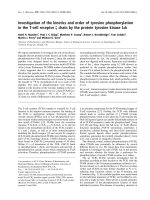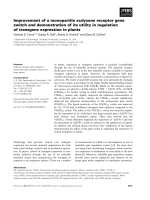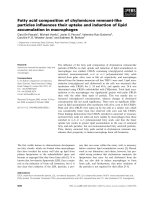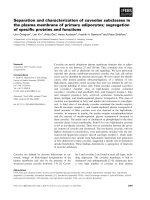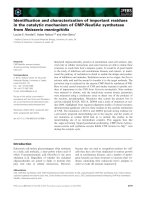Social participation and proactiveness of middle-class families in Vietnam
Bạn đang xem bản rút gọn của tài liệu. Xem và tải ngay bản đầy đủ của tài liệu tại đây (218.56 KB, 10 trang )
Social Participation and Proactiveness
of Middle-Class Families in Vietnam
Trinh Duy Luan1
1
Institute of Sociology, Vietnam Academy of Social Sciences.
Email:
Received on 1 August 2019.
Revised on 5 August 2019.
Accepted on 21 November 2019.
Abstract: The middle-class in Vietnam is now of considerable size, but its social participation and
proactiveness remain limited. Middle-class families have not yet engaged much in activities which
are socially constructive and critical. They pay more attention to aspects of daily life rather than
macro-social issues. They often react to issues with “safer” and more neutral actions rather than
socially-critical ones. A part of middle-class families is still apathetic or sceptical about the
possibility to address social issues surrounding them. The explanation for such a situation is that
the modern middle class in Vietnam has just been established and needs more time to develop and
assert their social responsibility as well as self-awareness of social status and contributions to the
current development of society.
Keywords: Middle-class families, social participation, social proactiveness, social issues.
Subject classification: Sociology
1. Introduction
This paper uses findings of the research
“Middle-Class Families in Vietnam with
Socio-economic and Cultural Development
Processes” under the Ministerial-level
research programme “Overall Assessment
Research on Families in Country’s
Industrialisation,
Modernisation
and
International Integration” led by the Vietnam
Academy of Social Sciences (VASS) in the
period 2016-2018. The research was
conducted in the middle of 2017 in
provinces and centrally-run cities, namely
Hanoi, Nam Dinh, Da Nang, and Ho Chi
Minh; and the sample size surveyed by
questionnaires was 2,200 households.
The research gained ground on three
social theories, namely social stratification,
structural functionalism, and symbolic
interactionism to analyse its contents.
While social stratification, especially the
income-based one was used for the
classification of households in the sample
based on their per capita income, the other
two theories helped study the statuses,
13
Vietnam Social Sciences, No. 2 (196) - 2020
roles, attitudes, and behaviours of households
in the current socio-economic and cultural
development processes.
In this research, middle-class families are
those households that have a per capita
income in the regulated range of the middle
class and must hold an upper secondary
degree or higher. In the five-level classification
scale of per capita income, Group 1 refers to
the lowest-income households (with a
monthly income of under VND 2.5 million);
and Group 5 refers to the highest-income
households (with a monthly income of over
VND 10 million). Groups 2, 3 and 4 are
middle-class families with incomes ranging
from VND 2.5 million to VND 10 million
and account for 71% of the surveyed sample.
The Group 1 of middle-class families
(MCF 1) is categorised with the household
owner/representative holding an upper
secondary degree or higher. The establishment
of such ranges was accomplished partly by
the reference to findings of home and
overseas studies on the middle class, data of
the Vietnam Living Standard Surveys
(VLSS) in the period 2010-2016, and sample
survey results of the research.
This article will focus on the social
participation and proactiveness of middleclass families in the socio-economic
development by comparing groups 1 and 2
with each other, as well as middle-class
families and groups 1 and 5.
2. The engagement of middle-class families
in social activities
The proactiveness of an individual or a
family can be shown through the level of
14
their participation in various social
activities, especially socially-critical ones,
which means putting forward opinions and
proposals on pressing socio-economic
affairs of the country or localities (via
different channels in a direct or indirect
manner). The research names the nine
following activities in order for middleclass families to indicate their participation
in the activities with four degrees (“usually”,
“sometimes”, “seldom” and “never”). The
result is presented below:
1. Making comments in written form or
sharing opinions in meetings and on mass
media about pressing socio-economic issues
of the country and locality.
2. Doing charitable work and making
philanthropic contributions (at the residential
places, workplaces, and in groups).
3. Taking part in anti-corruption activities.
4. Participating in activities which fight
against crimes and social evils.
5. Attending activities of mass organisations
such as the Vietnam Fatherland Front,
Vietnam Women’s Union, Farmer’s Union,
Veteran’s Association, and Youth Union (at
the residential places and workplaces).
6. Joining socio-professional organisations
(professional associations).
7. Participating in hobby-based groups
(art, sport, entertainment, etc.).
8. Taking part in groups of beliefs (visiting
temples and pagodas).
9. Writing statuses and comments on
social network sites (blogs, Facebook, etc.).
The social proactiveness can be reflected
through the total percentage of middle-class
families and their participation at all levels.
Trinh Duy Luan
To embolden their proactiveness, this
article will focus on analysing the
frequency that middle-class families engage
in such activities.
The following table and figure draw an
overarching picture about the levels of
families’ participation (through their
representatives) in social activities (see
Table 1).
Table 1: Middle-class Families usually Taking Part in Social Activities
(placed in the order of high-to-low)
Activities
Joining mass organisations
Doing charitable work
Joining hobby-based groups
Joining groups of beliefs
Writing statuses on social network sites
Making written comments
Fighting against crimes and social evils
Taking part in anti-corruption activities
Joining socio-professional organisations
Group 1
22.9
15.2
6.4
8.9
2.7
6.2
4.7
3.6
2.7
MCF1
34.9
26.4
13.2
14.9
5.6
6.3
8.3
5.3
5.8
MCF2
40.7
31.7
16.4
10.6
8.0
7.0
10.7
7.0
7.5
Group 5
40.2
38.5
22.1
13.9
13.1
9.0
7.4
7.4
7.5
Source: Dataset of the research “Middle-Class Families in Vietnam with Socio-economic
and Cultural Development Processes”, Overall Assessment Research on Families in
Country’s Industrialisation, Modernisation and International Integration, Vietnam
Academy of Social Sciences, 2016-2018.
The comparison among activities reveals
that the proportion of middle-class families
who usually take part in the activities never
exceeds 40%. This shows that the social
proactiveness of middle-class families is
still not high.
Specifically, middle-class families
show their most active participation in
regular activities of mass organisations
(MCF1: 34.9%; MCF2: 40.7%) and
charitable work (MCF: 26.4%; MCF2:
32.7%). Generally speaking, this high
level of participation in regular activities
of mass organisations is understandable
due to regulations of the current political
system structure. One-fourth to one-third
of all the surveyed middle-class families
are doing charitable work to develop a new
feature
in
fulfilling
their
social
responsibilities and showing their empathy
towards vulnerable groups in society.
Another 13-16% of middle-class
families usually join in hobby-based
groups and groups of beliefs to form a
newer mode of social participation, which
characterises middle-class families in
urban areas. Together with the enhanced
material life, the non-material life in these
areas is ever-more attended to.
15
Vietnam Social Sciences, No. 2 (196) - 2020
Figure 1: Middle-class Families 1 and 2 Joining Social Activities
Source: See Table 1.
The most noteworthy point when making
a comparison between the two groups of
activities is the fact that only quite a low
rate (5-10%) of middle-class families
usually takes part in the five remaining
activities (i.e. making comments in written
form or showing opinions in official
meetings; participating in anti-corruption
activities; joining activities which fight
against crimes and social evils; being
members of socio-professional organisations;
and writing statuses and comments on
social network sites). Oddly enough, these
are important activities of social discourse
and much expected to be made from
middle-class families. Even if the levels of
participation are combined, the indicators
for these activities are still considerably
16
lower in comparison to the other four
activities. Therefore, it is grounded to
conclude that the social participation (as a
factor of the social proactiveness) of
middle-class families in Vietnam remains
limited. Such level of social participation is
often related to
their citizenship
consciousness or level of knowledge while
being affected by a wide range of macro
political, socio-economic, and cultural
factors in Vietnam. Seemingly, middleclass families as a component of the middle
class in Vietnam are still in the formation
stage. They, thus, need more time to
continue improving their awareness and
sense of social responsibilities as well as
assert themselves as positive attributes of
the development of society.
Trinh Duy Luan
3. Evaluations and reactions of middleclass families to some social issues
3.1. Attitudes/evaluations of middle-class
families on current pressing social issues
Showing their attitude towards pressing
social issues is also an indicator of the
social proactiveness of middle-class
families. We have listed 11 such pressing
social issues so that middle-class families
can assess the urgency of each of the issues
by a scale with four levels (“serious”,
“worrisome”, “normal” and “no idea/no
interest”). The data indicate that three
categories of pressing social issues were
evaluated by middle-class families as
serious and worrisome and can be
classified from low to high as follows (see
Table 2 and attached figure).
Table 2: Middle-class Families Considering Social Issues to Be Serious and Worrisome
(placed in the order of high-to-low)
Social issues
Unsafe food
Environmental pollution
Unemployment
Drugs
Crime
Traffic jams
Traffic accidents
Corruption
Misconduct in management
Rich-poor polarisation
Violence
Group 1
36.0
39.2
32.4
23.3
25.7
12.5
23.7
11.5
10.2
28.0
9.6
MCF1
52.4
50.8
35.7
36.3
35.7
37.3
38.9
22.4
19.8
19.9
16.2
MCF 2
55.6
53.0
37.9
40.0
37.6
43.0
42.5
26.3
25.1
22.4
17.3
Group 5
70.5
58.2
36.9
42.6
37.7
57.4
50.0
39.4
37.7
32.8
22.2
Source: See Table 1.
The first group, including two issues,
namely environmental pollution and unsafe
food, is deemed to be “serious” and
“worrisome” by over 50% of middle-class
families. The second group, comprising five
issues, namely unemployment, drugs, crime,
traffic jams, and traffic accidents, is deemed to
be “serious” and “worrisome” by about 35%
of middle-class families. The third group,
consisting of four issues, namely corruption,
misconduct in management, violence, and
rich-poor polarisation, is considered to be
“serious” and “worrisome” by approx. 20% of
all the surveyed middle-class families.
The assessment rates of these issues
indicate that the surveyed middle-class
families in general have not evaluated
adequately all dangers of macro social issues.
They only pay more attention to urgent issues
of daily life such as environmental pollution,
unsafe food, traffic jams, and traffic
accidents, and show some interest in
17
Vietnam Social Sciences, No. 2 (196) - 2020
unemployment, drugs and crime. Social
issues such as corruption, misconduct in
management, violence, and the rich-poor
polarisation had the lowest rate of concern.
Figure 2: Middle-class Families 1 and 2 Evaluating Pressing Social Issues as "Serious"
and "Worrisome"
Source: See Table 1.
When comparing middle-class families
with families in Group 1 and Group 5, the
difference always exists. However, it still
depends on the compared issues. For
example, poor families often show little
attention to the larger social issues such as
corruption and misconduct in management or
even do not know about them. Therefore, the
percentage of issues which they consider to
be “serious” or “worrisome” is often just half
or one third as much as the corresponding
figure in middle-class families. For more
recognisable “micro” issues, the difference in
18
these percentages often stands at less than
two times. In general, it can be concluded that
the difference of middle-class families in
assessing and spotting risks of pressing social
issues is not much bigger in comparison to
the evaluation of poor families.
3.2. Reactions/actions of middle-class families
to pressing social issues
Reactions and actions of middle-class
families to current pressing social issues
are an indicator which reflects their social
Trinh Duy Luan
proactiveness in the clearest manner. Six
types of reactions/actions to pressing
social issues are shown in the following
table and figure:
Table 3: Reactions/Actions of Middle-class Families to Pressing Social Issues
No
What to do with pressing social issues
Group 1
MCF1
MCF2
Group 5
1.
2.
Sending written comments and proposals to
competent agencies
Expressing opinions through mass media
1.8
2.9
3.8
3.3
1.8
2.7
3.8
3.3
3.
Sharing opinions in official meetings
25.7
28.1
32.6
25.7
4.
Discussing with friends and relatives
46.7
60.9
64.5
63.3
5.
Doing nothing due to having no interest
34.7
22.2
17.6
17.5
6.
Doing nothing owing to disbelief in the
possibility of the issues able to be addressed
Total N
12.4
11.9
11.7
13.3
510
1543
982
120
Source: See Table 1.
Figure 3: Actions of Middle-class Families 1 and 2 to Pressing Issues
Source: See Table 1.
19
Vietnam Social Sciences, No. 2 (196) - 2020
Reactions/actions of middle-class families
to the above-mentioned pressing social
issues can be also classified into three
following groups:
Firstly, they “discuss and complain with
friends and relatives about pressing social
issues”, which stands out with the highest
prevalence (60.9%). For the next kind of
reaction, one fourth of the families in the
sample and one third of middle-class
families 2 often “make comments in official
meetings”. Although the percentage is not
high, this kind of reaction is more positive
than the first one. Notably, this form of
reaction is expressed quite uniformly with
few disparities among groups with different
living standards. The majority of families
opted for “moderately reasonable” and
other safe options when reacting to current
urgent social issues.
Secondly, there are two kinds of reactions
(1 and 2) which show the greatest
proactiveness yet draw the lowest levels of
participation from middle-class families. The
prevalence of such reactions never exceeds
3% and concentrates more on middle-class
families, especially ones in the group of
“upper middle-class families” (5.4%). This
prevalence is the lowest in the group of poor
families (1.8% for both kinds of reactions).
More importantly, the prevalence of
these reactions in the group of rich families
(Group 5) is even lower than that in the
group of middle-class families. This
indicates a trend, in which middle-class
families have a higher social proactiveness
than poor families and wealthy families.
Better-off families seem to be so satisfied
with their personal lives that they are, to
some extent, apathetic about the current
pressing social issues. This also emboldens
the social role or proactiveness of middle20
class families in interrelations with the
socio-economic development in comparison
to other social groups.
Thirdly, there are two kinds of reactions
of indifference and passiveness of middleclass families to pressing social issues. One
fourth of the families (with one fifth of
middle-class families) on average answered
that they “do nothing due to having no
interest”. The second kind of reaction of
indifference, “doing nothing due to
disbelief in the possibility of the issues able
to be addressed”, which is of a pessimistic
and doubtful nature, has quite a uniform
rate (approx. over 10%) in all groups of
families, regardless of their living standards.
Combining the two reactions, one can see
that 34.1% or around one third, of middleclass families neglect or do not pay attention
to the current pressing social issues.
Due to their higher levels of education,
middle-class families in Group 2 show better
social proactiveness than those families in
Group 1 in almost all reactions (except for
the last two types of reactions of indifference
and passiveness, which tend to be opposite)
yet with a difference of no more than 5%.
Notably, with the sixth reaction - “Doing
nothing due to disbelief in the possibility of
the issues able to be addressed” - its
prevalence is almost uniform as a constant
(11-12%) in all income groups. This also
reflects the “social mood” which is closely
linked to the social transition and
development in Vietnam.
4. Conclusion
Through research on the social participation
and proactiveness of middle-class families,
the following conclusions can be drawn:
Trinh Duy Luan
Firstly, very few middle-class families
(5-7%) usually take part in activities which
show social proactiveness and social
discourse such as making written
comments or expressing opinions in official
meetings; participating in anti-corruption
activities; joining activities which fight
against crimes and social evils, and others.
Being formed only recently, middle-class
families in Vietnam seem to need more
time to consolidate their awareness and
actions which demonstrate their sense for
social responsibility and affirm positive
attributes of the class in the process of
social development.
Secondly, in regarding of current pressing
social issues, the majority of middle-class
families often focus more on specific ones
which are related to their daily life such as
environmental pollution, unsafe food,
traffic jams and accidents, unemployment,
drugs, and crime. Meanwhile, very few
middle-class families are concerned about
larger social issues such as corruption,
misconduct in management, violence, and
the rich-poor polarisation.
Thirdly, to the aforementioned urgent
social issues, the majority of middle-class
families
often
choose
moderate
reactions/actions such as “discussing with
friends and relatives” and “sharing opinions
in official meetings”. The most active
reactions/actions such as “sending written
comments and proposals to competent
agencies” and “expressing opinions through
mass media” are indicated by very few
middle-class families.
Notably, one third of all the surveyed
middle-class families show reactions of
indifference or neglect towards urgent
social issues and are sceptical about the
possibility to them being addressed.
The social participation and proactiveness
of middle-class families as presented through
some above-mentioned indicators are also
often not uniform. Even though their
proactiveness is greater than that of poor
families, or even that of wealthy families in
some activities, the common trend can be
described as that “the social proactiveness
tends to be higher in the wealthy families or
families with members working as leaders,
managers, staff, and salary earners, i.e. the
professions of the so-called “new middle
class”, which are located at the upper half of
the socio-occupational stratification pyramid.
However, the difference is often not so big,
which reflects the continuation in the
transition and mobility among income groups
or in middle-class families themselves.
On the one hand, this research’s findings
show the active role of middle-class
families to some extent in comparison to
other groups of families. However, there are
limitations in both attitudes and practical
actions, and the overall social participation
and proactiveness of middle-class families
remain low and inadequate. Meanwhile,
with the requirements of the real-world
development as well as expectations of
society at present, the social proactiveness
is a crucial and necessary attribute, which
must be elevated to a core property of
middle-class families. Therefore, in
addition to considering the middle class as a
huge economic actor, it is necessary to
develop favourable policies for them to
continue to practice, experience, and
improve the self-awareness of their
qualities, identities, and roles, thereby
making more contributions to the socioeconomic development in Vietnam.
21
Vietnam Social Sciences, No. 2 (196) - 2020
Note
[4]
Lê Kim Sa (2014), "Tầng lớp trung lưu ở Việt
Nam: quan điểm tiếp cận, thực tiễn phát triển và
1
các kiến nghị chính sách", Báo cáo Tổng hợp Đề
The paper was published in Vietnamese in: Nghiên
tài cấp bộ của Trung tâm Phân tích và Dự báo,
cứu Gia đình và Giới, số 3, 2018. Translated by Vu
Xuan Nuoc, edited by Etienne Mahler.
Viện Hàn lâm Khoa học xã hội Việt Nam. [Le
Kim Sa (2014), “Middle Class in Vietnam:
Viewpoints on Approaches, Actual Development
and Policy Recommendations”, Executive Report
References
on Ministerial-level Research of Centre for
[1]
Bùi Đại Dũng (2014), "Quy mô tầng lớp
Analysis and Forecast, Vietnam Academy of
trung lưu tại Việt Nam theo tiêu chí thu
Social Sciences].
nhập", Tạp chí Kinh tế và Chính trị Thế giới,
[5]
số 6 (218). [Bui Dai Dung (2014), “Size of
bộ "Gia đình trung lưu ở Việt Nam với các
Middle Class in Vietnam Based on Income
quá trình phát triển kinh tế - xã hội - văn
Criterion”, Journal of World Economics and
Politics, No. 6 (218)].
hóa", Nghiên cứu đánh giá tổng thể về gia
đình thời kỳ công nghiệp hóa, hiện đại hóa
đất nước, hội nhập quốc tế, Viện Hàn lâm
[2]
Khoa học xã hội Việt Nam, 2016-2018.
: Nhìn lại một số khía
[3]
of
the
research
“Middle-Class
cạnh phương pháp luận từ cách tiếp cận xã hội
[Dataset
học", Tạp chí Xã hội học, số 3. [Trinh Duy
Families in Vietnam with Socio-economic and
Luan (2004), “Social Stratification in Vietnam
Cultural Development Processes”, Overall
at
Assessment
Present:
Reviewing
A
Number
of
Research
on
Families
in
Methodological Aspects from Perspective of
Sociology”, Journal of Sociology, No. 3].
Country’s Industrialisation, Modernisation
Trịnh Duy Luân (2017), "Nghiên cứu về tầng
Academy of Social Sciences, 2016-2018].
lớp trung lưu: từ kinh nghiệm châu Á đến
22
Số liệu và Báo cáo chuyên đề của Đề tài cấp
and
[6]
International
Integration,
Vietnam
Nguyễn Thanh Tuấn (2007), "Về nhóm xã hội
thực tiễn Việt Nam", Tạp chí Xã hội học, số
trung lưu ở Việt Nam hiện nay", Tạp chí Cộng
2. [Trinh Duy Luan (2017), “Research on
sản, số 2+3 (122+123). [Nguyen Thanh Tuan
Middle Class: From Experience of Asia to
(2007), “On Middle-Class Social Group in
Actual Situation in Vietnam”, Journal of
Sociology, No. 2].
Vietnam at Present”, Communist Review, No.
2+3 (122+123)].




